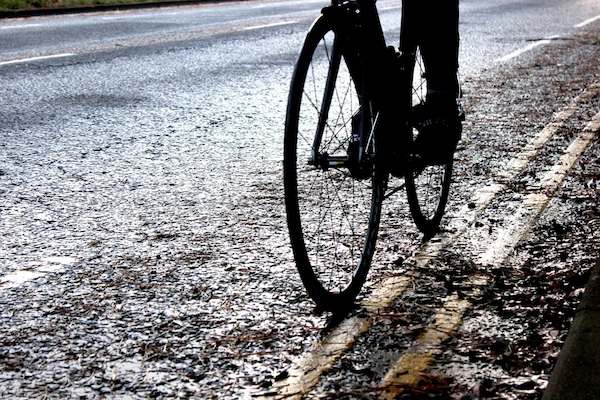Dealing with Spring Road Conditions
 Road conditions are a huge problem with spring riding. During the winter, a ton of grit and salt gets dumped on roads to keep them grippy and snow-free, and, come spring time, all of that stuff ends up in one place – the shoulder where you want to ride. Spring is also pothole season, as water seeps into cracks in the road and freezes overnight, threatening to open up holes the size of the Grand Canyon in your favorite roads. There are a few easy things you can do to beat these obstacles and have a safe and enjoyable spring riding season.
Road conditions are a huge problem with spring riding. During the winter, a ton of grit and salt gets dumped on roads to keep them grippy and snow-free, and, come spring time, all of that stuff ends up in one place – the shoulder where you want to ride. Spring is also pothole season, as water seeps into cracks in the road and freezes overnight, threatening to open up holes the size of the Grand Canyon in your favorite roads. There are a few easy things you can do to beat these obstacles and have a safe and enjoyable spring riding season.
Staying Flat-Free
Nobody likes to change a flat tire, and the side of a road in a spring downpour is about the worst time to have to do it. But this time of year seems to produce an abnormal number of frustrating flats. The culprit? Road grit. As it builds up on the side of the road, it collects all the little bits of stuff that would normally get blown off into the ditch – pieces of glass, metal shards, nails, etc. Normal, lightweight road tires get torn up in these conditions.
To keep you riding, a durable, puncture-resistant tire is essential. These tires have Kevlar fabric, or something like it integrated into the casing of the tire to strengthen it. Most major tire manufacturers offer at least one model like this. They won’t be the lightest, or the smoothest rolling tires, but they will take a beating. I have the Continental Gatorskins on my bike right now that are a nice balance of performance and protection. The same company also makes even more durable (and heavier) tires – the GatorHardShell and the Grand Prix 4-Season. Other options include the Specialized Armadillo and Schwalbe Marathon Plus.
Pothole Avoidance
Weaving your way through the obstacle course that some spring roads tend to turn into can be a daunting task, but there are a couple of tricks that will help you out. The simplest is to look where you want to go, rather than looking at all the things you want to avoid. If you have ever managed to hit the only rock/hole/whatever on a nice smooth stretch of road because you were staring straight at it, you will know how well this works. Look ahead, pick your path through the debris, and then follow that path with your eyes. Your body will guide your bike there without you having to think about it.
As skillful a bike slalomer as you might be, occasionally there will be times that you can’t go around something – maybe you are on a shoulder with cars to your right, or you might be in a group with other riders. Whatever the situation, you need to take alternative action. Enter the bunny hop. If you haven’t heard the term before, the general idea is to ‘jump’ your bike – both wheels leave the ground for an instant. This isn’t something that you want to try out for the first time at 25 mph on pavement – find a grass field to practice on. With clipless pedals, the task is considerably easier. There are countless YouTube tutorials out there, but in short, you are going to ‘hop off’ your pedals (not literally, since your feet are clipped in), and then bring the bike up along with you. Don’t think about pulling the bike up first – your body has be be airborne before your bike can follow. When you’ve got the hang of the maneuver on grass, try it out at slow speeds on the road before working your way up to full speed.
Embrace the Fender
Grit and water aren’t much fun to ride through, and they are even less fun when you end up covered in them during a ride. Fenders are your friend for spring riding. They keep you (relatively) dry, grit-free, and they also keep all that same stuff from getting into your drivetrain, reducing maintenance and keeping your bike running smoothly. The type of bike you have will determine what your fender options are. For full-fledged race bikes choices are limited since attachment points and tire clearance are minimal. The SKS Race Blade fender is just about the only good option.
With lower-end road bikes, and touring/cyclocross bikes, you have more possibilities. Some people like clip-on fenders, since you can take them off at the end of the season to keep your bike looking slick. The downside to these are they won’t offer the same coverage and performance as a dedicated bolt-on fender set. If I just had one bike, I’d probably use clip-ons, but with my current set-up – one touring/commuting/spring riding bike, and another race/summer riding bike – I like bolt-on fenders that I leave on my commuting bike year-round. Whatever you choose, it will be light-years better than going without!